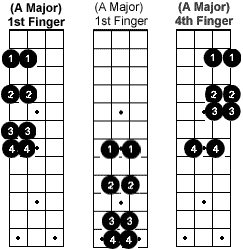« Paul Glasse on composition and line |
Main
| Animated Sheet Music; So What »
 November 7, 2013 | Best of JM: Octave Splicing November 7, 2013 | Best of JM: Octave Splicing
Enjoy the popular archive material below.
From October 9, 2008 | Octave Splicing
The beauty of the 5ths tuned instruments is pattern movability. That's a constant theme in our frequent FFcP nuggets and offerings--learn a riff, scale segment, or arpeggio in one place, you can copy it to another string or fret in a different region of the fretboard.

There are two ways to do this. One is to completely move everything using the same exact fingering, the other is to start the pattern with a different finger, maintain the same note relationships but use a different incarnation of the four FFcP patterns. It's obvious in the A scale we've shown above, and could approach an A Maj7 arpeggio or A blues riff repeated in a second octave, as well.
After getting familiar with FFcP, you might start getting a little too comfortable staying in the same section of the fretboard. It's a good idea to move around though, taking the next step of adjusting known patterns above the 7th fret where the spacings are closer, and less familiar in feel. You'll also want to be able to connect these nuggets in a smooth way and start thinking how you can extend your playing across the fretboard, and not just across the strings. Starting a two octave riff on the 2nd fret and ending it on the 11th is not a natural skill, and something to nurture and develop over time.

The toughest thing to do in the transition is making the shift in hand position seamless. The simplest way to start is with major scales, but you can do this with pentatonics and 7th chord arpeggios too. Focus very hard on that shift, making it as natural as you can.
Two benefits you get from this, an even deeper mental and tactile understanding of how notes and their functions stack up all over the neck, and the ability to extend a solo phrase into a 2nd or even 3rd octave... Fearlessly!
Try splicing your own octave patterns into two octave patterns in your practice regimen.
Further:
Moving Horizontally
Patterns Overboard.
Leading Off Third Base: The benefits of third position fingering.
Moving on up. And around.
Enjoy 2 Page PDF:  Moving on Up Moving on Up
Posted by Ted at November 7, 2013 6:15 PM

Disclaimer: In the 'Information Age' of the 21st Century,
any fool with a computer, a modem, and an idea can
become a self-professed 'expert." This site does not
come equipped with 'discernment.'
|



